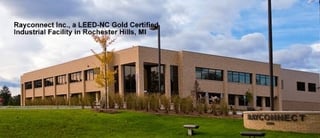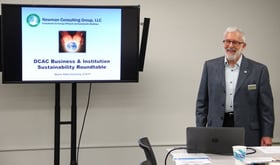Use of the word sustainability, based on recorded mentions, skyrocketed starting in the early 1980s and has grown exponentially over the past 3 decades. In the past few weeks alone I have attended two exceptional programs on sustainability, and I see many more in the near and distant future as it becomes a hotter topic at the various green building and commercial real estate industry conferences to which I am invited.
Just because it is used more, does that mean it’s really used more? Is sustainability all talk? What does it mean to companies today who want to be - and be seen as - sustainable?
I believe most people agree that at the very least sustainable means minimal to no impact on the environment – without losing money! (A business also needs to sustain income.)
But is your company sustainable if you produce something that minimally impacts the environment, while still being profitable? Is it the raw materials, the manner of production, the transportation? Or is it the product that makes it green? What if you don’t produce a consumable product, i.e., you’re service based? Is your company sustainable only if the building where you work is “green?” Or does your company have – and adhere to - “green” procurement and waste policies?
In short, there are many ways to define sustainability, and many more ways to put it into practice. Change in this area is coming faster and faster. And you better be on board or you’ll be left behind! (Get the new Guide, "Why - and How to - Transform an Existing Building into a Sustainable Facility."
Let’s take a look at a few examples of incorporating sustainability and sustainable building practices and principles in which Newman Consulting Group has been involved: (Also see "Reducing Energy Cost: Why Do It and How To Pay For It.")
- Ford: Ford is the whole package with active and engaged sustainability teams for both products and work environment. With a continually evolving lineup of vehicle offerings Ford is known for their many high-mileage offerings. What many people don’t know is that Ford is committed to the LEED process (Leadership in Energy and Environmental Design). As part of the Dearborn Campus Transformation, there are 13 LEED EBOM (Existing Building Operations and Management) projects underway (submitted and under review) and 32 projects planning to undergo certification under LEED for New Construction & Major Renovations.
Ford expects LEED Gold certification for new construction and LEED Silver certification for major renovations. LEED certification is just one aspect of Ford’s commitment to building sustainability. The company has set its own sustainability goals, metrics and targets for both the buildings and site at the Dearborn campus.
- Rayconnect: Rayconnect’s parent company ARaymond is based in France where sustainability is more ingrained in the business culture. Fully committed to green manufacturing, the company employs only highly efficient, low- energy production machine, and insists all buildings are “green,” like this one in Rochester, MI.
- Kelly Services: Here’s an example where the service is the product. Since they don’t have a product or manufacturing process to “green” they chose a different route with similar goals. First they worked to make their building more environmentally friendly by using low VOC paints and materials, managing their waste streams, changing their lighting to LED Lamps, and continually monitoring their HVAC systems to ensure they were using as little energy as possible. Then they educated their staff on what they did in the building and what the staff could do at home, creating a ripple effect of positive environmental impact.
I recently had the honor of speaking to the DCAC Business & Institution Sustainability Roundtable, a program of Detroiters Working for Environmental Justice. I was able to discuss what I see, and what I believe the industry holds true, as the four main benefits of green design, environmental, health and safety, community and economic:
- Environmental Benefits - Reduce the Impacts of Natural Resource Consumption
- Health and Safety Benefits - Enhance Occupant Comfort and Health
- Community Benefits - Minimize Strain on Local Infrastructure and Improve Quality of Life
- Economic Benefits - Improve the Top and Bottom Lines
 I covered some of these in an article last fall in the Construction Association of Michigan (CAM) magazine on "Making Green and Sustainable Design Really Work."
I covered some of these in an article last fall in the Construction Association of Michigan (CAM) magazine on "Making Green and Sustainable Design Really Work."
When considering long-term sustainability, you also have to think about your future workforce. Just enter the search term “millennials and green jobs” and you’ll see this is a hot topic!
As Forbes magazine noted in this article in 2014, “Many more of the undergrads and MBAs today are looking into working for NGOs, or at least for corporations which have serious Corporate Social Responsibility programs.” Another Forbes article that same year specified that “Millennials will favor companies that show a demonstrated commitment to sustainability and social improvement.”
Not only is it important to Millennials to work for a “sustainable” company. To be truly successful, the company also must engage those Millennial employees – and all the other employees – in the sustainability efforts. Just in the last five years, much has been written on this topic.
In an article published last year in the Stanford Social Innovation Review, Paul Polman, CEO of Unilever, writes that “most businesses are coming around to the fact that sustainability is critical. Besides the financial benefits that sustainability practices like energy conservation provide, studies have found that employee retention, productivity, and overall engagement all go up.”
So, I believe, this is where we are headed. Sustainable building practices, like those Newman Consulting Group has built our business on over the past 15 years, are not enough anymore. Sustainability must be incorporated throughout the business. For those companies and organizations not already engaging their employees and customers this way, we are helping them find ways to meet those needs so they can have a sustainable financial future as well.




